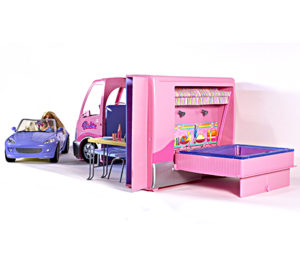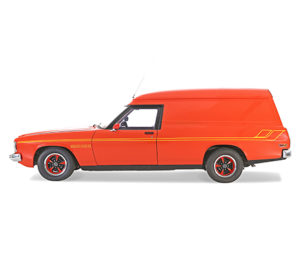Need help to know how to post your response. Check FAQ page.
05
Nov 19Barbie and the Sandman
The Barbie Campervan definitely reminds me of my childhood. But then, so does the Holden Sandman. Not because such a beast ever roamed the streets of Connecticut. Although this photo depicts a full-size vehicle, it reminds me of the Matchbox and Hot Wheels cars I collected as a kid. Yes, I had both a Barbie campervan (thanks, grandparents!) and a vinyl case of Matchbox and Hot Wheels cars. A vinyl case of Barbie clothes and minuscule shoes as well as a Tonka Jeep that Barbie was just a little too big to fit into. Many of my Hot Wheels cars were violently-hued, like the Sandman. But the big difference lies between those campervans. Mine, unlike the updated version, was orange and yellow, as was seemingly every other thing in the 1970s. I can’t look at it without thinking of the Mystery Machine from Scooby-Doo.
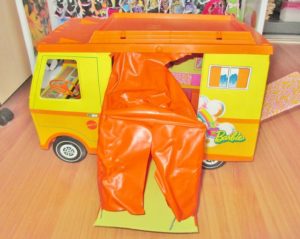
1971 Barbie Country Camper
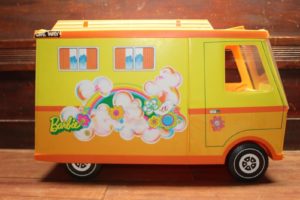
Barbie Country Camper, side view
This is the model I had, the inaugural 1971 Barbie Country Camper, created before curves had been invented. Shagadelic, no? It was essentially a laminated cereal box with wheels. I can still smell the fresh vinyl, feel the silk-screened flower patterns on the surface. The van’s dimensions were laughably out of scale with Barbie, Ken and GI Joe as well, who could be relied upon to come crashing through the forest at some point during every camping adventure. And yes, the tarpaulin entry hall on mine displayed the same tear-away durability as the one in the photo, probably about two weeks after its Christmas arrival.
The flimsy kitsch didn’t matter to me one bit because it was a real Barbie toy, the same as I assumed all the other girls at school had. Christmas was when I could (usually) count on “real” toys, brand-name toys, not hand-me-downs or knock-offs from the discount store. Once in adulthood, I came across a stash of my letters to Santa that my mother had saved. In them, I was always careful (emphatic, truth be told) to ask Santa for “real” toys. That meant the ones from the TV ads and the Sears catalogue. The ones I wouldn’t be embarrassed to invite my friends over to play with if I had ever been allowed to.
Although part of me wanted to fit in with the girls, I didn’t want to play jump rope or sit next to the wall braiding hair and talking during recess. I wanted to be running around, playing ball or climbing on the jungle gym or spinning way too fast on the merry-go-round. So I usually played with the boys. And Matchbox cars that looked like the Sandman, along with baseball cards and dinosaur toys, helped me fit in with them as well.
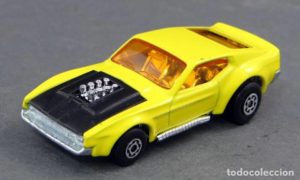
Matchbox 44 Boss Mustang, 1970
It sounds shallow and commercialised now, of course. But as a kid, all you really want is to fit in, to feel like you belong. Those “real” toys were keys: They opened doors to acceptance and made me feel like I did fit in with the other kids at school, even though I knew that I didn’t quite.
The first thing that didn’t fit was that my absent father was a black man from Jamaica. My parents had been separated for a few years by the time I started school. And although I don’t recall anyone in my family ever telling me in so many words, I knew these things—his blackness, his absence, his foreignness—were things I shouldn’t talk about at school. Or anywhere else.
Another unfitting thing was my only-ness. Being an only child until age 15, I spent most of my time—no, all my time—around adults when I wasn’t at school. I also didn’t live in a “real” neighbourhood, as the rest of the kids did. My house sat down a narrow, dead-end country road where the houses on my side were far apart and the only people inside were old folks. The other side of the road was just the woods—the bush, to Australian readers—for miles.
I was also a heavy kid so my clothes were often homemade—not bespoke—either by my mother or my grandmother, because the cute kids’ clothes like Garanimals didn’t fit me. And since I spent all my time around adults and read a lot, kids thought I was weird and used “big words”.
So “real” toys helped me find common ground.
They were the right toys, but not always the right toys. I didn’t always want to play with the toys that were “right” for me as a girl. It was fine in kindergarten, even first and second grade. But as we grew older, the little girls and boys who were enlisted into the gender role border patrol let me know (oh, so kindly, as kids do) which toys were right and which were wrong. Learning which toys were “right” and “wrong” taught me which parts of me were okay and which ones I’d have to hide if I wanted to fit in.
Identity work starts young. We edit ourselves with the audience in mind. We code-switch. We show some things about ourselves—our race, our class, our sexuality—to some folks in some places. But never others. And sometimes we get so good at stashing away bits of ourselves, we forget where we put them.
